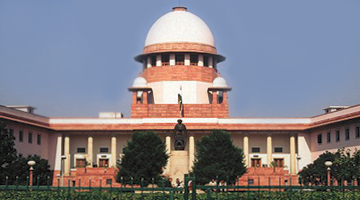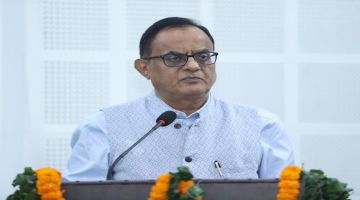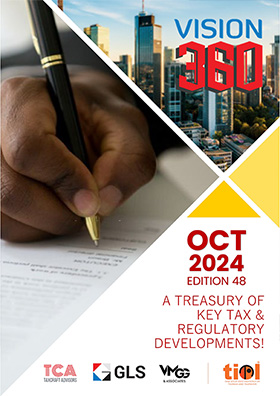I-T - Operation of Rule 8D for allocating expenditure in relation to exempt income is prospective in nature: SC
By TIOL News Service
NEW DELHI, JAN 31, 2018: THE issue before the Bench is - Whether operation of Rule 8D for allocating expenditure in relation to exempt income is prospective in nature. And the SC verdict is YES.
Facts of the case
The Assessee-company filed its return of income for the relevant AY. During the assessment proceedings, the AO observed that the Assessee was in in receipt of both taxable and non taxable dividend income. Accordingly, the AO sent notice u/s 143(2) and thereafter, dividend on investment exempt u/s 10(23G) was considered by the AO for the purpose of disallowance u/s 14A. Therefore, proportionate interest relating to investment on which exemption u/s.10(23G) was available as per the working amounting to Rs.26 crores was disallowed u/s 14A r.w.s. 10(23G) of the Act. On Assessee's appeal, the CIT(A) partly allowed the appeal. On further appeal by the Assessee, the Tribunal allowed the appeal relying on the Bombay High Court’s judgment in the case of Godrej and Boyce Manufacturing Company Limited held that Rule 8D is only prospective and in the year under consideration Rule 8D was not applicable. Thereafter, the Revenue filed an appeal before the High Court, which following its earlier judgment in the case of Godrej and Boyce Manufacturing Company Limited dismissed the appeal.
After hearing the parties, the Apex Court held that,
++ subsection (2) and subsection (3) were inserted in Section 14A by Finance Act, 2006. The memorandum explaining the provision in Finance Bill, 2006, in reference to the methods for allocating expenditure in relation to exempt income as extracted above clearly mentions that amendments brought by Finance Bill, 2006 will take effect from 01.04.2007. The methodology for determining amount of the expenditure in addition to income not includable in total income was for the first time prescribed by Rule 8D as was envisaged in Section 14A subsection (2) and subsection (3). It is also relevant to notice that Constitution Bench in the Commissioner of Income Tax Vs. Vatika Township Pvt. Ltd., has also referred to and relied the CBDT circular to find out the understanding of the Central Board of Direct Tax itself in context of Provision which was in issue in the above case;
++ explanatory memorandum issued with the Finance Bill, 2006 and the CBDT circular dated 28.12.2006, thus, clearly indicates that department understood that subsection (2) and subsection (3) was to be implemented with effect from assessment year 2007-2008. The Rule 8D prescribing the method was brought into statute book with effect from 24.03.2008 to implement subsection (2) and subsection (3) with effect from assessment year 2007-2008, is clear indicator of the fact that a new method for computing the expenditure was brought in by the rules which was to be utilized for computing expenditure for the Assessment Year 2007-2008 and onwards;
++ it is to be noted that Section 14A was inserted by Finance Act, 2001 and the provisions were fully workable without their being any mechanism provided for computing the expenditure. Although Section 14A was made effective from 01.04.1962 but Proviso was immediately inserted by Finance Act, 2002, providing that Section 14A shall not empower assessing officer either to reassess under Section 147 or pass an order enhancing the assessment or reducing a refund already made or otherwise increasing the liability of the assessees under Section 154, for any assessment year beginning on or before 01.04.2001. Thus, all concluded transactions prior to 01.04.2001 were made final and not allowed to be reopened. The memorandum of explanation explaining the provisions of Finance Act, 2006 has clearly mentioned that Section 14 subsection (2) and subsection (3) shall be effective with effect from the assessment year 2006-07 alone which is another indicator that provision was intended to operate prospectively;
++ the method for determining the amount of expenditure brought in force w.e.f. 24.03.2008 has been given a gobye and a new method has been brought into force w.e.f. 02.06.2016, by interpreting the Rule 8D retrospective, there will be a conflict in applicability of 5th & 14th Amendment Rules which clearly indicates that the Rule has a prospective operation, which has been prospectively changed by adopting another methodology;
++ applying the principles of statutory interpretation for interpreting retrospectivity of a fiscal statute and looking into the nature and purpose of subsection (2) and subsection (3) of Section 14A as well as purpose and intent of Rule 8D coupled with the explanatory notes in the Finance Bill, 2006 and the departmental understanding as reflected by Circular dated 28.12.2006, the Court is of the considered opinion that Rule 8D was intended to operate prospectively;
++ the judgment in this appeal relies on earlier judgment of Bombay High Court in Godrej and Boyce Manufacturing Company Limited, where the Division Bench of the Bombay High court after elaborately considering the principles to determine the prospectivity or retrospectivity of the amendment has concluded that Rule 8D is prospective in nature. Against such judgment of the Bombay High court dated 12.08.2010 an appeal was filed in this court which has been decided by vide its judgment reported in Godrej and Boyce Manufacturing Company Limited. This Court, while deciding the above appeal repelled the challenge raised by the assessee regarding vires of Section 14A. In para 36 of the judgment, this Court noticed that with regard to retrospectivity of provisions Revenue had filed appeal, hence the said question was not gone into such appeal. In the above case, this Court specifically left the question of retrospectivity to be decided in other appeals filed by the Revenue. The Court thus have proceeded to decide the question of retrospectivity of Rule 8D in these appeals. In view of the opinion as expressed, dismissal of the appeal by the Bombay High Court is fully sustainable. The Rule 8D is prospective in operation and could not have been applied to any assessment year prior to Assessment Year 2008-09.
(See 2018-TIOL-41-SC-IT)















